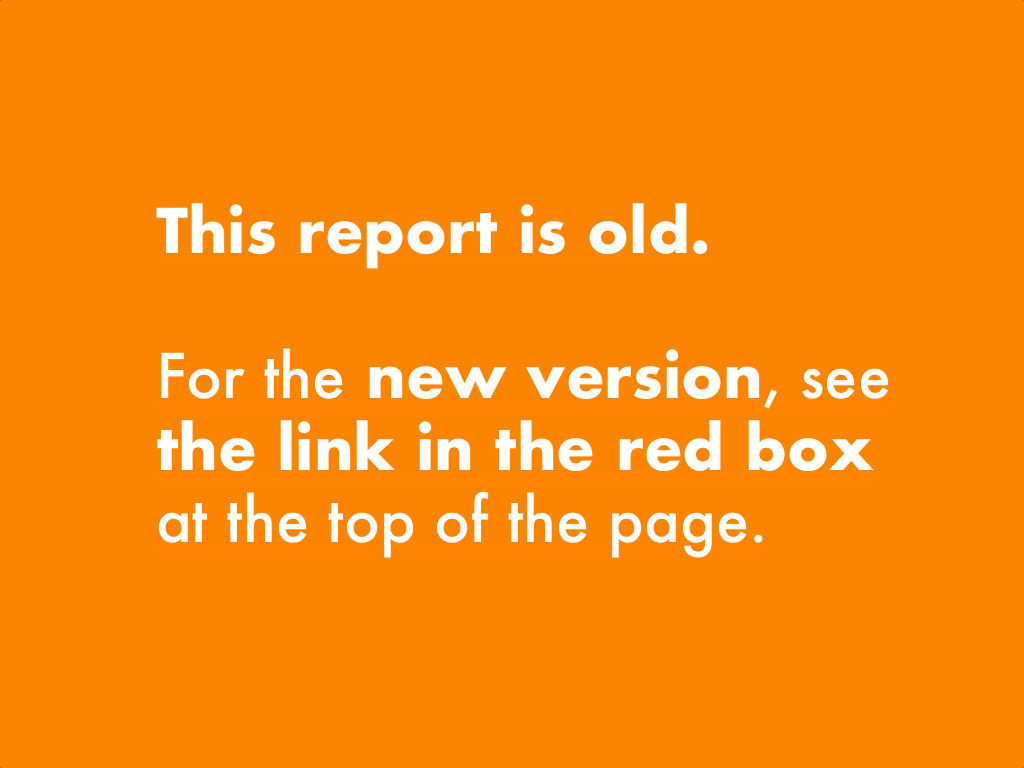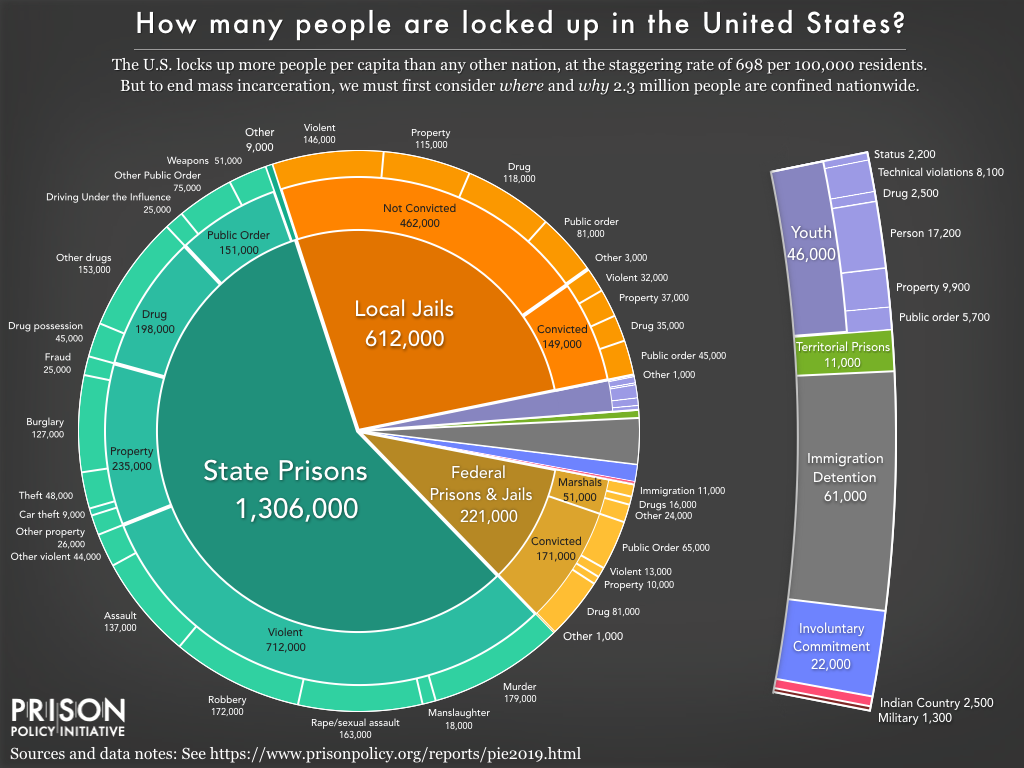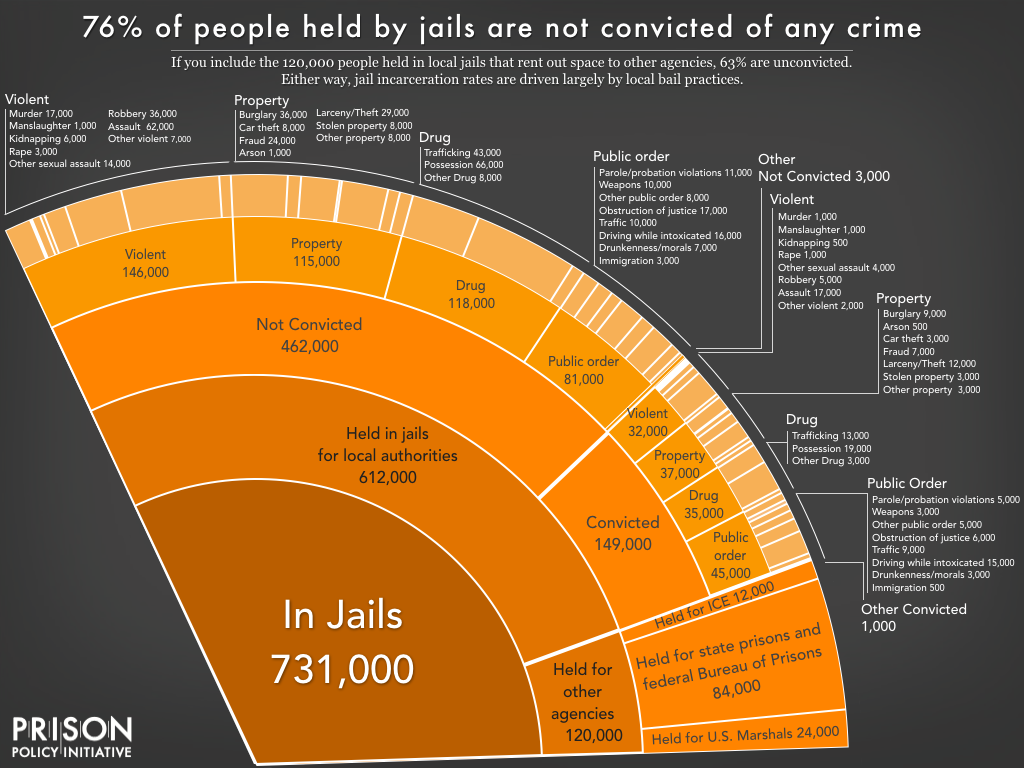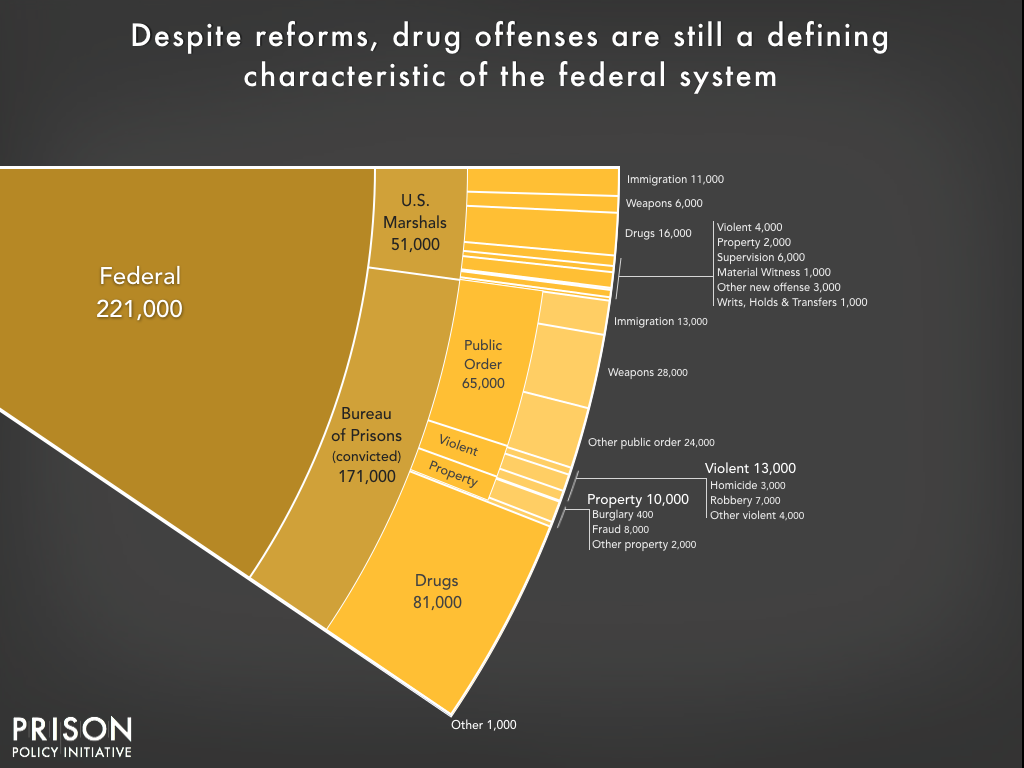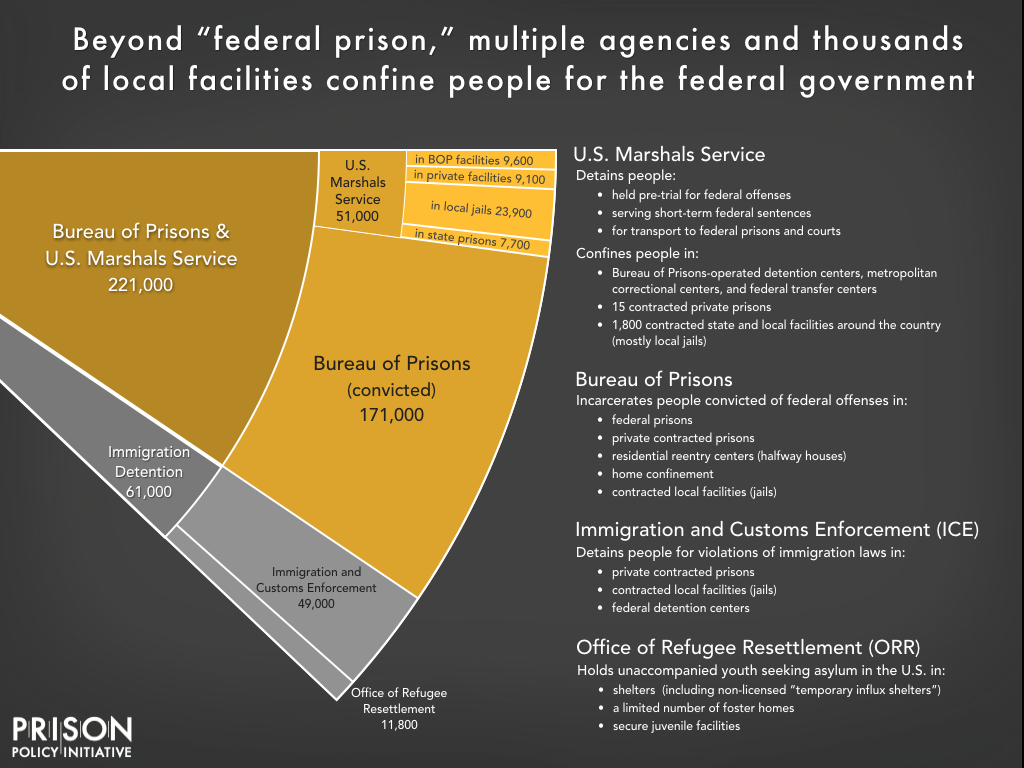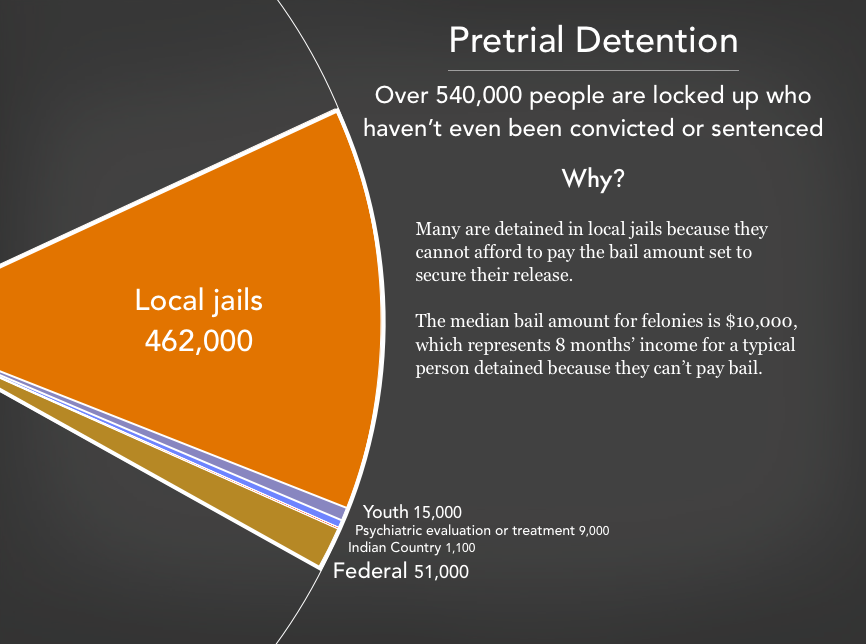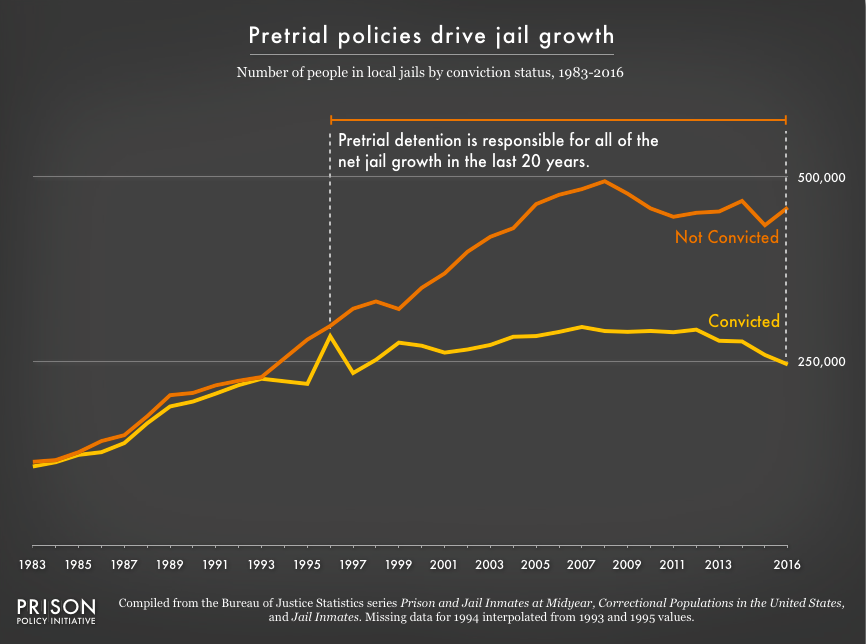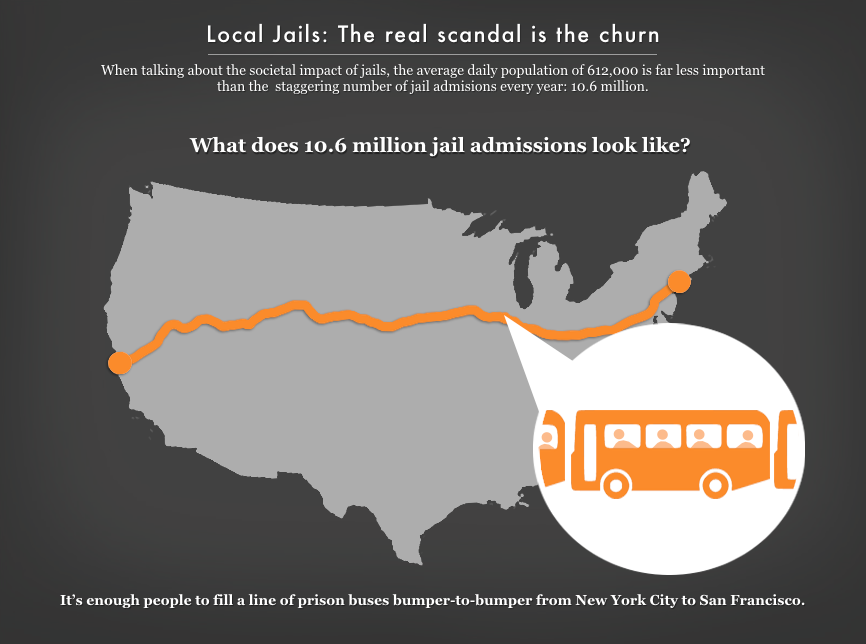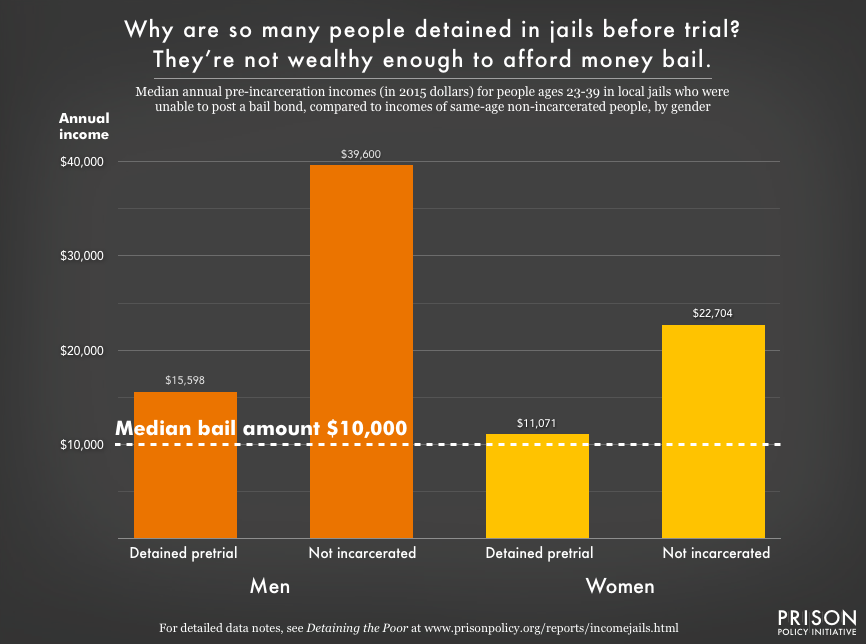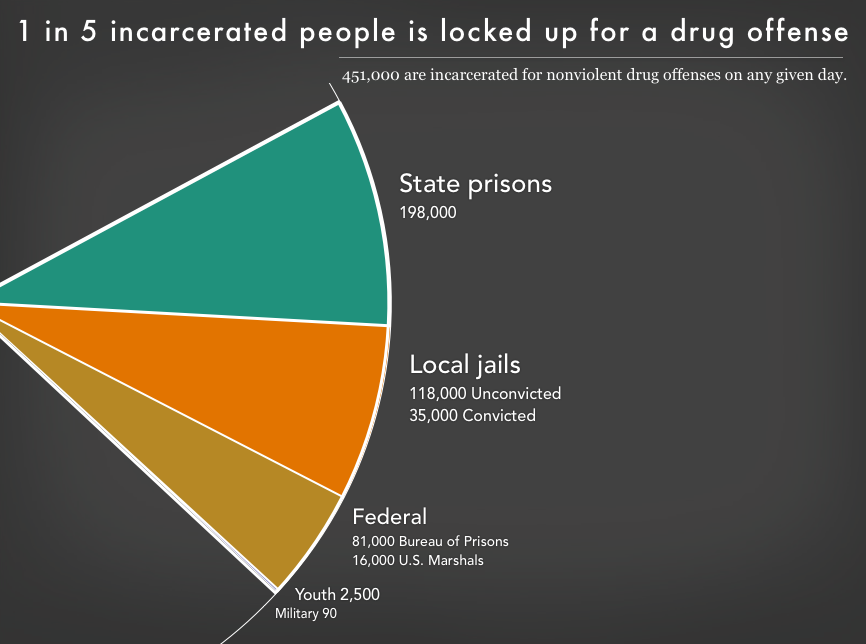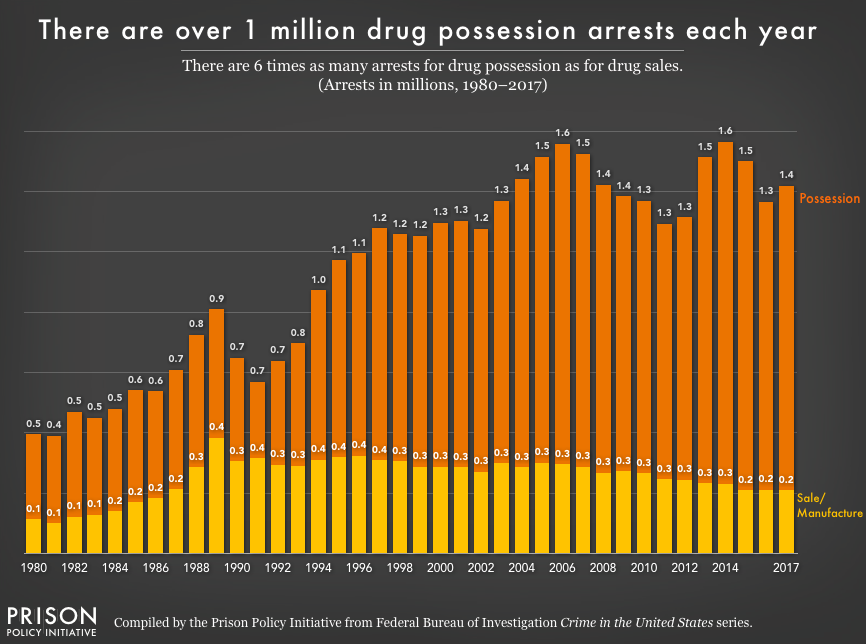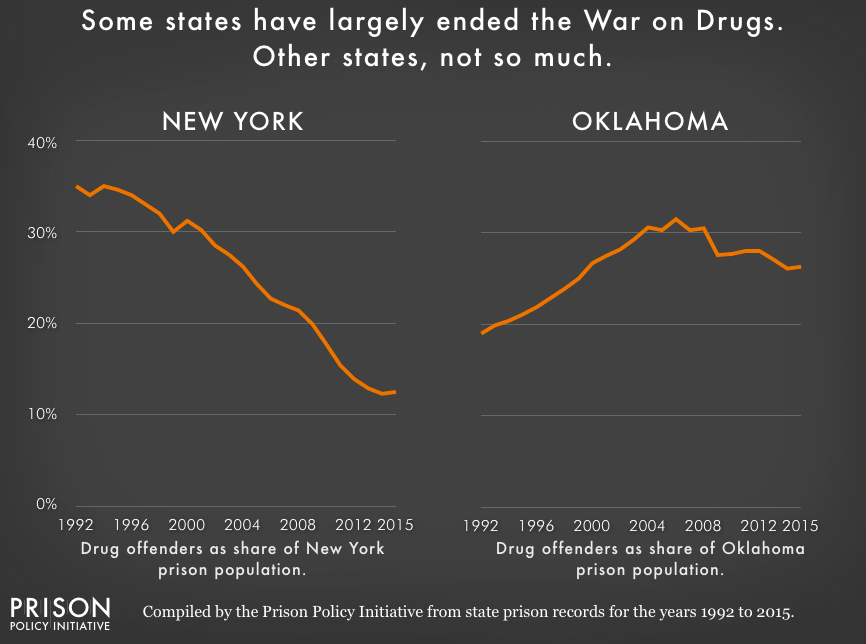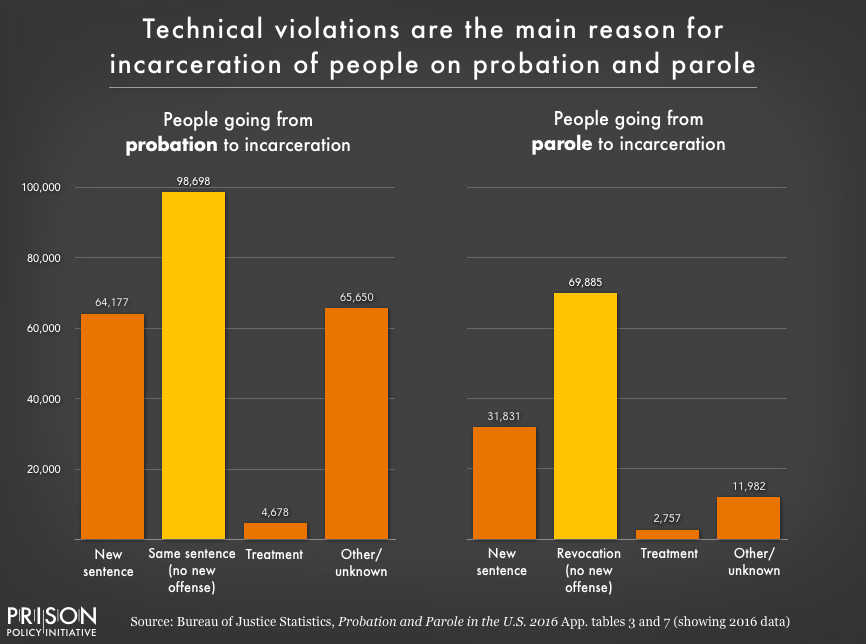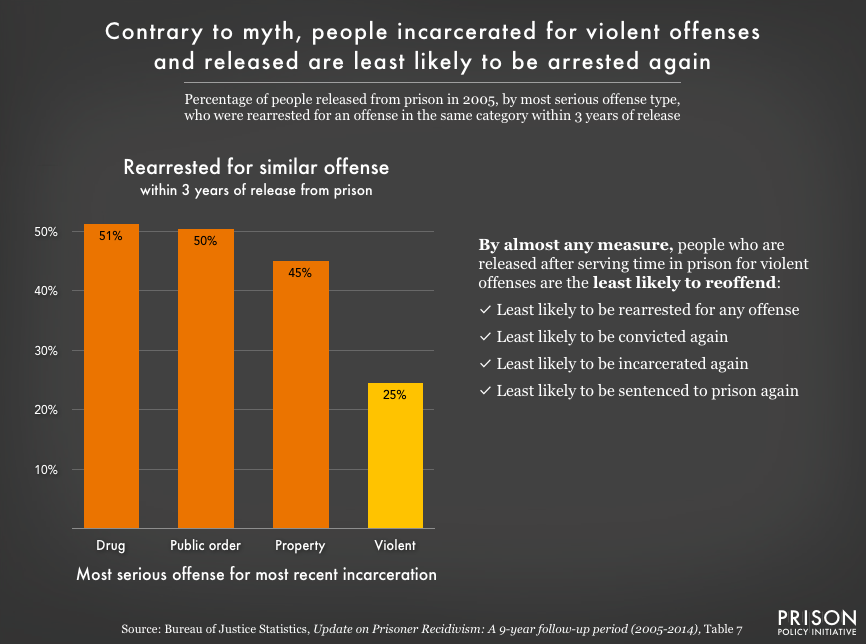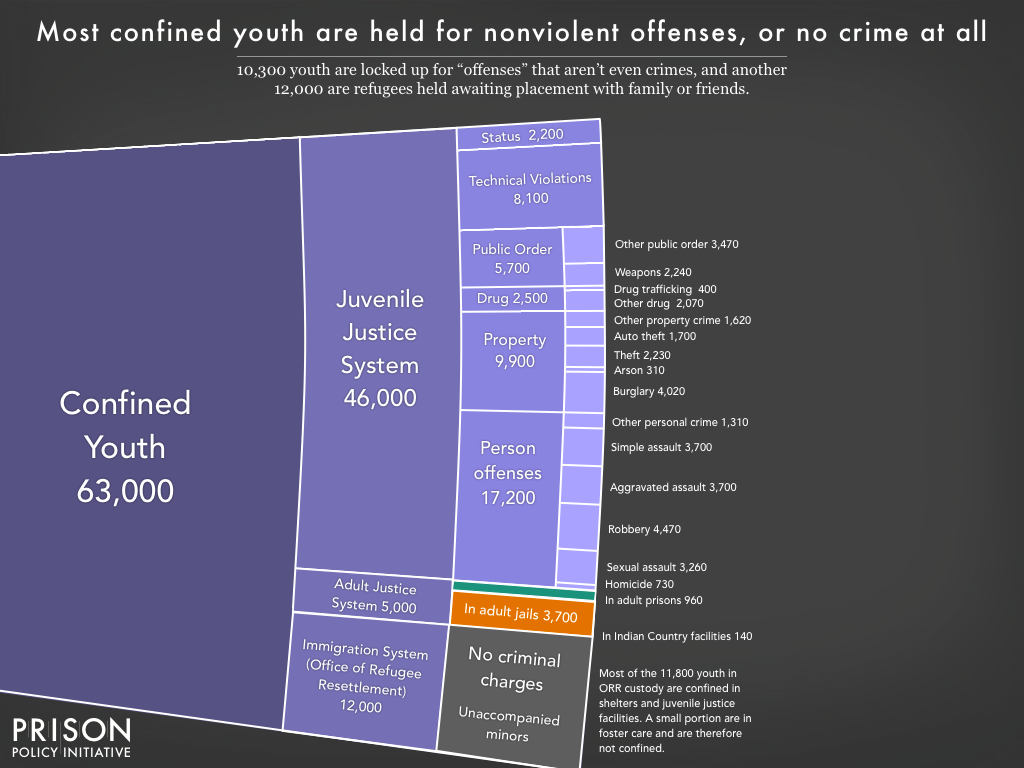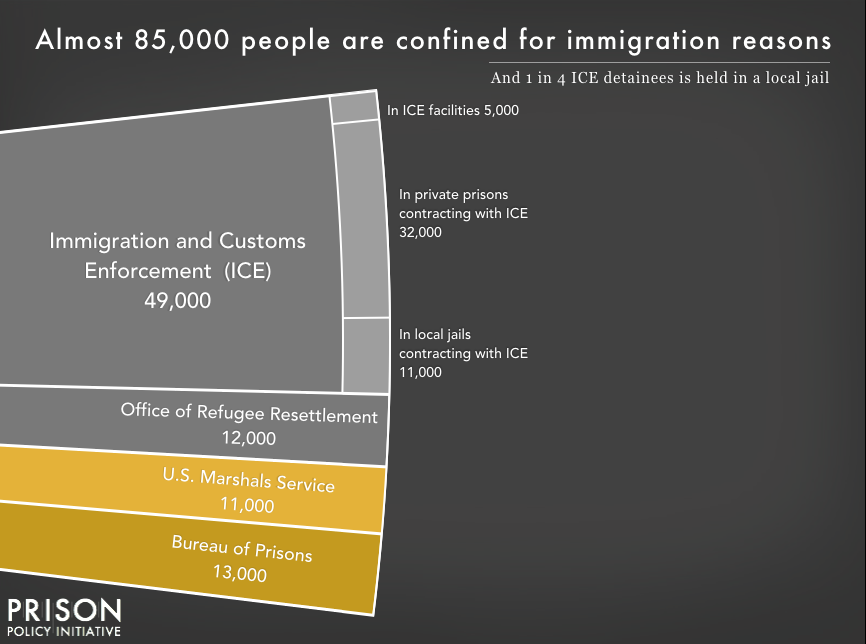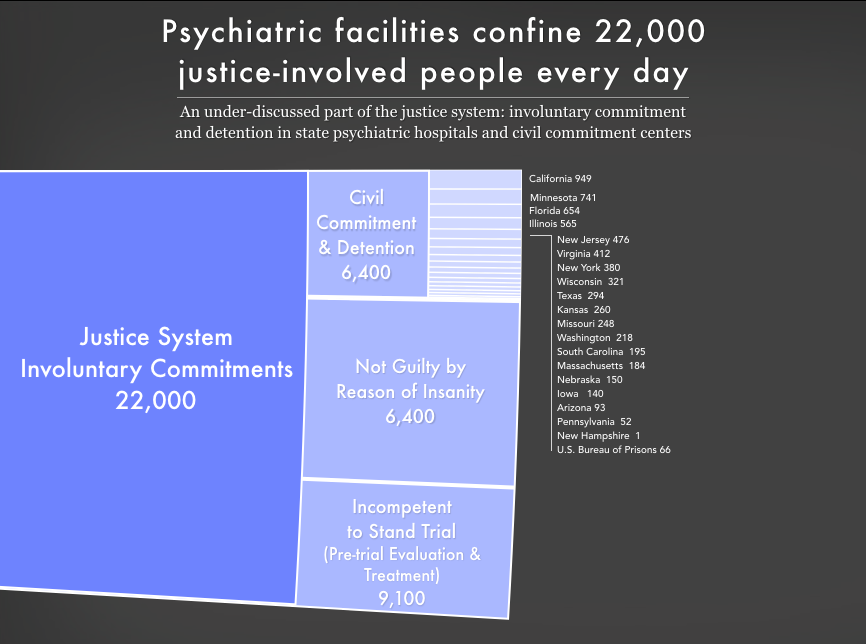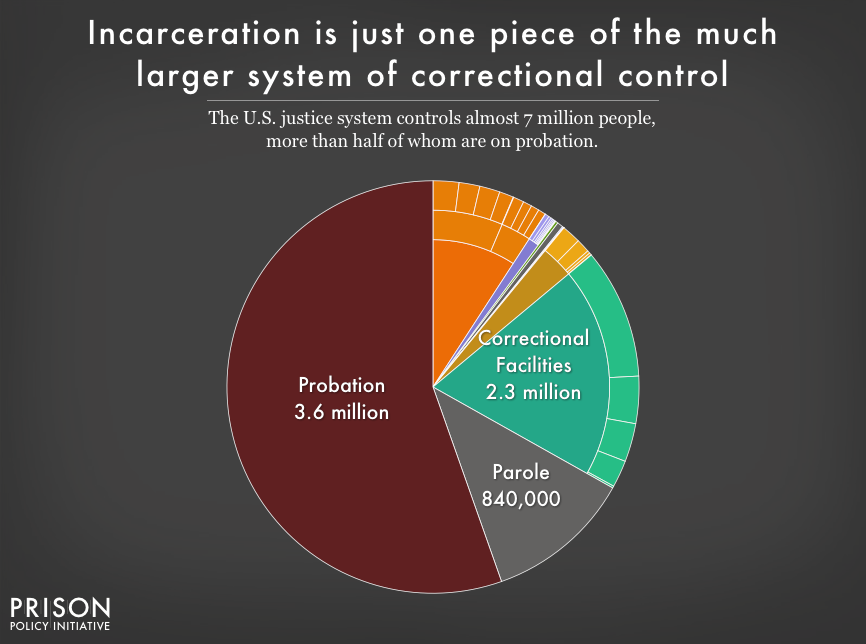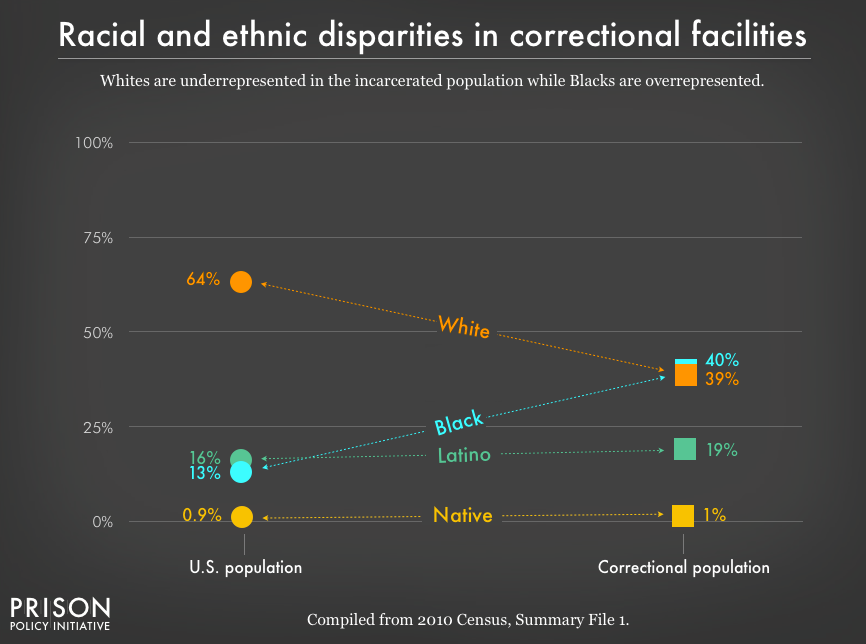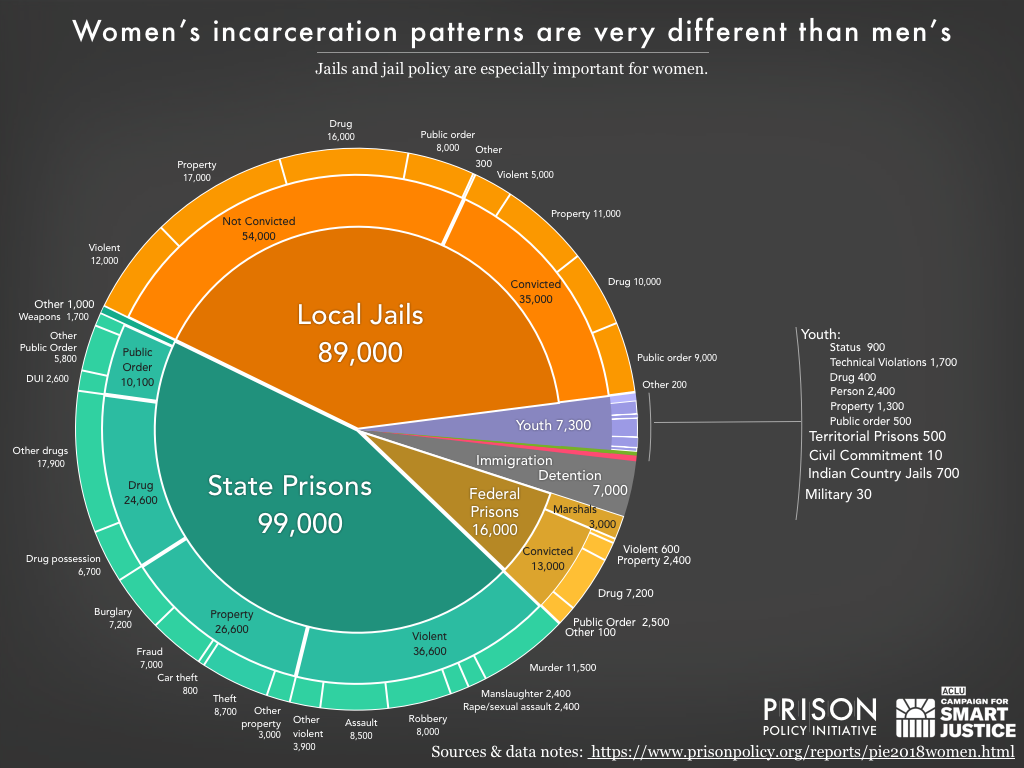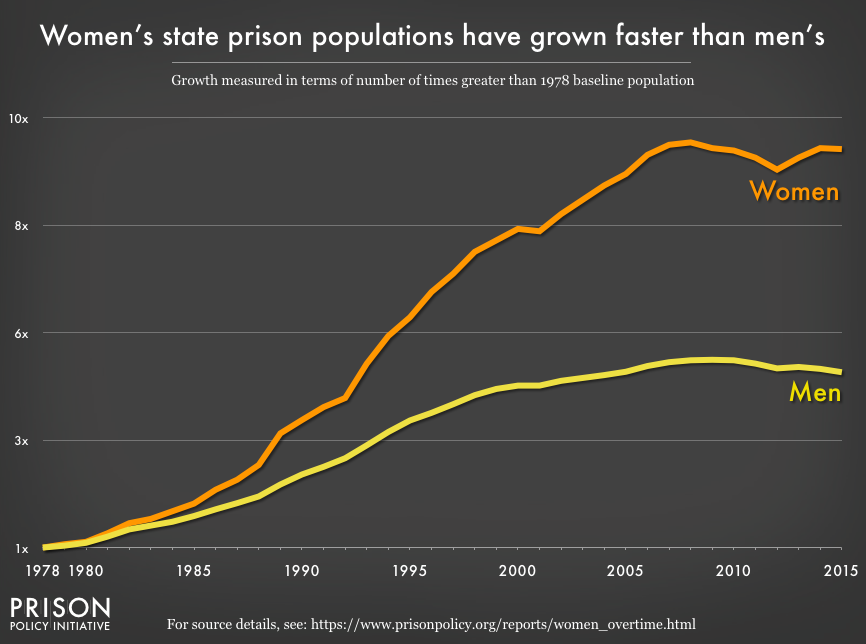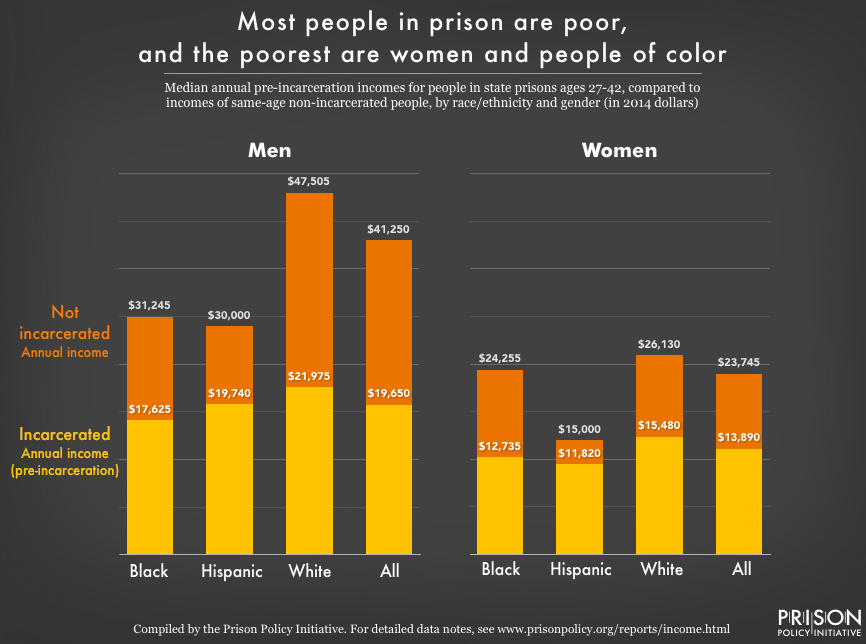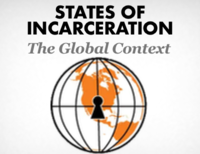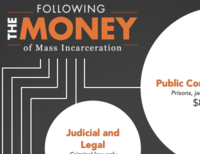Mass Incarceration: The Whole Pie 2019
By Wendy Sawyer and Peter Wagner
March 19, 2019
This report is old. See our new version.
Can it really be true that most people in jail are being held before trial? And how much of mass incarceration is a result of the war on drugs? These questions are harder to answer than you might think, because our country’s systems of confinement are so fragmented. The various government agencies involved in the justice system collect a lot of critical data, but it is not designed to help policymakers or the public understand what’s going on. As public support for criminal justice reform continues to build, however, it’s more important than ever that we get the facts straight and understand the big picture.
This report offers some much needed clarity by piecing together this country’s disparate systems of confinement. The American criminal justice system holds almost 2.3 million people in 1,719 state prisons, 109 federal prisons, 1,772 juvenile correctional facilities, 3,163 local jails, and 80 Indian Country jails as well as in military prisons, immigration detention facilities, civil commitment centers, state psychiatric hospitals, and prisons in the U.S. territories.1 This report provides a detailed look at where and why people are locked up in the U.S., and dispels some modern myths to focus attention on the real drivers of mass incarceration.
Slideshow 1. Swipe for more detailed views.
This big-picture view allows us to focus on the most important drivers of mass incarceration and identify important, but often ignored, systems of confinement. The detailed views bring these overlooked systems to light, from immigration detention to civil commitment and youth confinement. In particular, local jails often receive short shrift in larger discussions about criminal justice, but they play a critical role as “incarceration’s front door” and have a far greater impact than the daily population suggests.
While this pie chart provides a comprehensive snapshot of our correctional system, the graphic does not capture the enormous churn in and out of our correctional facilities, nor the far larger universe of people whose lives are affected by the criminal justice system. Every year, over 600,000 people enter prison gates, but people go to jail 10.6 million times each year.2 Jail churn is particularly high because most people in jails have not been convicted.3 Some have just been arrested and will make bail within hours or days, while many others are too poor to make bail and remain behind bars until their trial. Only a small number (less than 150,000 on any given day) have been convicted, and are generally serving misdemeanors sentences under a year.
Slideshow 2. Swipe for more detail on pre-trial detention.
With a sense of the big picture, the next question is: why are so many people locked up? How many are incarcerated for drug offenses? Are the profit motives of private companies driving incarceration? Or is it really about public safety and keeping dangerous people off the streets? There are a plethora of modern myths about incarceration. Most have a kernel of truth, but these myths distract us from focusing on the most important drivers of incarceration.
Five myths about mass incarceration
The overcriminalization of drug use, the use of private prisons, and low-paid or unpaid prison labor are among the most contentious issues in criminal justice today because they inspire moral outrage. But they do not answer the question of why most people are incarcerated, or how we can dramatically — and safely — reduce our use of confinement. Likewise, emotional responses to sexual and violent offenses often derail important conversations about the social, economic, and moral costs of incarceration and lifelong punishment. Finally, simplistic solutions to reducing incarceration, such as moving people from jails and prisons to community supervision, ignore the fact that “alternatives” to incarceration often lead to incarceration anyway. Focusing on the policy changes that can end mass incarceration, and not just put a dent in it, requires the public to put these issues into perspective.
The first myth: Releasing “nonviolent drug offenders” would end mass incarceration
It’s true that police, prosecutors, and judges continue to punish people harshly for nothing more than drug possession. Drug offenses still account for the incarceration of almost half a million people,4 and nonviolent drug convictions remain a defining feature of the federal prison system. Police still make over 1 million drug possession arrests each year,5 and many of these arrests do lead to prison sentences. Drug arrests continue to give residents of over-policed communities criminal records, hurting their employment prospects and increasing the likelihood of longer sentences for any future offenses.
But at the state and local levels, far more people are locked up for violent and property offenses than for drug offenses alone. To end mass incarceration, reforms will have to go further than the “low hanging fruit” of nonviolent drug offenses. (As it happens, some of the boldest strategies for reforming the criminal justice system — such as heavy investments in social services and community-based alternatives to incarceration — benefit not only those with substance use disorders, but people at risk of incarceration for any offense.)
Slideshow 3. Swipe for more detail on the War on Drugs.
The second myth: Private prisons are the corrupt heart of mass incarceration
In fact, less than 8% of all incarcerated people are held in private prisons; the vast majority are in publicly-owned prisons and jails.6 Some states have more people in private prisons than others, of course, and the industry has lobbied to maintain high levels of incarceration, but private prisons are essentially a parasite on the massive publicly-owned system — not the root of it.
Nevertheless, a range of private industries and even some public agencies continue to profit from mass incarceration. Many city and county jails rent space to other agencies, including state prison systems,7 the U.S. Marshals Service, and Immigration and Customs Enforcement (ICE). Private companies are frequently granted contracts to operate prison food and health services (often so bad they result in major lawsuits), and prison and jail telecom and commissary functions have spawned multi-billion dollar private industries. By privatizing services like phone calls, medical care and commissary, prisons and jails are unloading the costs of incarceration onto incarcerated people and their families, trimming their budgets at an unconscionable social cost.
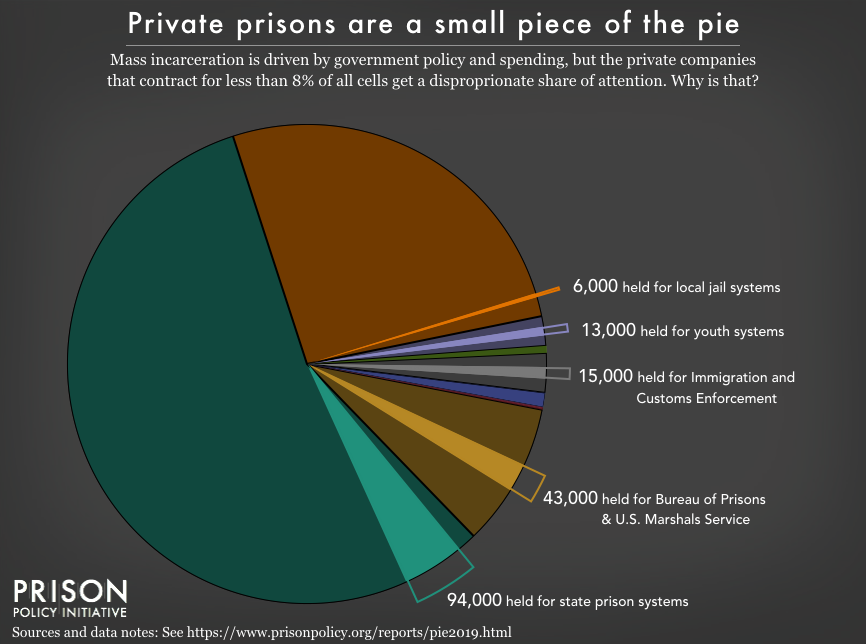 Private prisons and jails hold less than 8 percent of all incarcerated people, making them a relatively small part of a mostly publicly-run correctional system.
Private prisons and jails hold less than 8 percent of all incarcerated people, making them a relatively small part of a mostly publicly-run correctional system.
The third myth: Prisons are “factories behind fences” that exist to provide companies with a huge slave labor force
Simply put, private companies using prison labor are not what stands in the way of ending mass incarceration, nor are they the source of most prison jobs. Only about 5,000 people in prison — less than 1% — are employed by private companies through the federal PIECP program, which requires them to pay at least minimum wage before deductions. (A larger portion work for state-owned “correctional industries,” which pay much less, but this still only represents about 6% of people incarcerated in state prisons.)8
But prisons do rely on the labor of incarcerated people for food service, laundry and other operations, and they pay incarcerated workers unconscionably low wages: our 2017 study found that on average, incarcerated people earn between 86 cents and $3.45 per day for the most common prison jobs. In at least five states, those jobs pay nothing at all. Moreover, work in prison is compulsory, with little regulation or oversight, and incarcerated workers have few rights and protections. Forcing people to work for low or no pay and no benefits allows prisons to shift the costs of incarceration to incarcerated people — hiding the true cost of running prisons from most Americans.
The fourth myth: Expanding community supervision is the best way to reduce incarceration
Community supervision, which includes probation, parole, and pretrial supervision, is often seen as a “lenient” punishment, or as an ideal “alternative” to incarceration. But while remaining in the community is certainly preferable to being locked up, the conditions imposed on those under supervision are often so restrictive that they set people up to fail. The long supervision terms, numerous and burdensome requirements, and constant surveillance (especially with electronic monitoring) result in frequent “failures,” often for minor infractions like breaking curfew or failing to pay unaffordable supervision fees.
In 2016, at least 168,000 people were incarcerated for such “technical violations” of probation or parole — that is, not for any new crime.9 Probation, in particular, leads to unnecessary incarceration; until it is reformed to support and reward success rather than detect mistakes, it is not a reliable “alternative.”
Slideshow 4. Swipe for more detail about what the data on recividism really shows.
The fifth myth: People in prison for violent or sexual crimes are too dangerous to be released
Finally, we come to the myth that people who commit violent or sexual crimes are incapable of rehabilitation and thus warrant many decades or even a lifetime of punishment. As lawmakers and the public increasingly agree that past policies have led to unnecessary incarceration, it's time to consider policy changes that go beyond the low-hanging fruit of “non-non-nons” — people convicted of non-violent, non-serious, non-sexual offenses. If we are serious about ending mass incarceration, we will have to change our responses to more serious and violent crime.
The data supports changing our responses to some of the crimes that scare people most: people convicted of sexual assault and homicide are actually among the least likely to reoffend after release. People convicted of homicide are the least likely to be re-arrested, and those convicted of rape or sexual assault have re-arrest rates roughly 30-50% lower than people convicted of larceny or motor vehicle theft. More broadly, people convicted of any violent offense are less likely to be re-arrested in the years after release than those convicted of property, drug, or public order offenses. Yet people convicted of violent offenses often face decades of incarceration, and those convicted of sexual offenses can be committed to indefinite confinement or stigmatized by sex offender registries long after completing their sentences.
Offense categories might not mean what you think
To understand the main drivers of incarceration, the public needs to see how many people are incarcerated for different offense types. But the reported offense data oversimplifies how people interact with the criminal justice system in two important ways: it reports only one offense category per person, and it reflects the outcome of the legal process, obscuring important details of actual events.
First, when a person is in prison for multiple offenses, only the most serious offense is reported.10 So, for example, there are people in prison for violent offenses who were also convicted of drug offenses, but they are included only in the “violent” category in the data. This makes it hard to grasp the complexity of criminal events, such as the role drugs may have played in violent or property offenses. We must also consider that almost all convictions are the result of plea bargains, where defendants plead guilty to a lesser offense, possibly in a different category, or one that they did not actually commit.
Secondly, many of these categories group together people convicted of a wide range of offenses. For violent offenses especially, these labels can distort perceptions of individual “violent offenders” and exaggerate the scale of dangerous violent crime. For example, “murder” is an extremely serious offense, but that category groups together the small number of serial killers with people who committed acts that are unlikely, for reasons of circumstance or advanced age, to ever happen again. It also includes offenses that the average person may not consider to be murder at all. In particular, the felony murder rule says that if someone dies during the commission of a felony, everyone involved can be as guilty of murder as the person who pulled the trigger. Acting as lookout during a break-in where someone was accidentally killed is indeed a serious offense, but many may be surprised that this can be considered murder in the U.S.11
Lessons from the smaller “slices”: Youth, immigration, and involuntary commitment
Looking more closely at incarceration by offense type also exposes some disturbing facts about the 63,000 youth in confinement in the United States: Too many are there for a “most serious offense” that is not even a crime. For example, there are over 8,100 youth behind bars for technical violations of their probation, rather than for a new offense. An additional 2,200 youth are locked up for “status” offenses, which are “behaviors that are not law violations for adults, such as running away, truancy, and incorrigibility.”12 Nearly 1 in 10 youth held for a criminal or delinquent offense is locked in an adult jail or prison, and most of the others are held in juvenile facilities that look and operate a lot like prisons and jails.
Turning to the people who are locked up criminally and civilly for immigration-related reasons, we find that 13,000 people are in federal prisons for criminal convictions of immigration offenses, and 10,600 more are held pretrial by U.S. Marshals. The vast majority of people incarcerated for criminal immigration offenses are accused of illegal entry or illegal re-entry — in other words, for no more serious offense than crossing the border without permission.13
Slideshow 5. Swipe for more detail about youth confinement, immigrant confinement and psychiatric confinement.
Another 49,000 people are civilly detained by U.S. Immigration and Customs Enforcement (ICE) not for any crime, but simply for their undocumented immigrant status. ICE detainees are physically confined in federally-run or privately-run immigration detention facilities, or in local jails under contract with ICE. An additional 11,800 unaccompanied children are held in the custody of the Office of Refugee Resettlement (ORR), awaiting placement with parents, family members, or friends. While these children are not held for any criminal or delinquent offense, most are held in shelters or even juvenile placement facilities under detention-like conditions.14
Adding to the universe of people who are confined because of justice system involvement, 22,000 people are involuntarily detained or committed to state psychiatric hospitals and civil commitment centers. Many of these people are not even convicted, and some are held indefinitely. 9,000 are being evaluated pre-trial or treated for incompetency to stand trial; 6,000 have been found not guilty by reason of insanity or guilty but mentally ill; another 6,000 are people convicted of sexual crimes who are involuntarily committed or detained after their prison sentences are complete. While these facilities aren't typically run by departments of correction, they are in reality much like prisons.
Beyond the “Whole Pie”: Community supervision, poverty, and race and gender disparities
While this report provides the most inclusive view of the various systems of confinement in the U.S. justice system available, these snapshots can’t capture all of the important systemic issues. Once we have wrapped our minds around the “whole pie” of mass incarceration, for example, we should zoom out and note that confinement is just one piece of the larger system of correctional control. There are another 840,000 people on parole and a staggering 3.6 million people on probation. Given the onerous conditions of probation and the steep consequences for technical violations, policymakers should be wary of "alternatives to incarceration" that can easily lead to incarceration for people who pose no threat to public safety.
Beyond identifying the parts of the criminal justice system that impact the most people, we should also focus on who is most impacted and who is left behind by policy change. Poverty, for example, plays a central role in mass incarceration. People in prison and jail are disproportionately poor compared to the overall U.S. population.15 The criminal justice system punishes poverty, beginning with the high price of money bail: The median felony bail bond amount ($10,000) is the equivalent of 8 months' income for the typical detained defendant. As a result, people with low incomes are more likely to face the harms of pretrial detention. Poverty is not only a predictor of incarceration; it is also frequently the outcome, as a criminal record and time spent in prison destroys wealth, creates debt, and decimates job opportunities.16
It's no surprise that people of color — who face much greater rates of poverty — are dramatically overrepresented in the nation's prisons and jails. These racial disparities are particularly stark for Black Americans, who make up 40% of the incarcerated population despite representing only 13% of U.S residents. The same is true for women, whose incarceration rates have for decades risen faster than men's, and who are often behind bars because of financial obstacles such as an inability to pay bail. As policymakers continue to push for reforms that reduce incarceration, they should avoid changes that will widen disparities, as has happened with juvenile confinement and with women in state prisons.
Slideshow 6. Swipe for more detail about race, gender and income disparities.
Equipped with the full picture of how many people are locked up in the United States, where, and why, our nation has a better foundation for the long overdue conversation about criminal justice reform. For example, the data makes it clear that ending the war on drugs will not alone end mass incarceration, though the federal government and some states have taken an important step by reducing the number of people incarcerated for drug offenses. Looking at the “whole pie” also opens up other conversations about where we should focus our energies:
- Are state officials and prosecutors willing to rethink not just long sentences for drug offenses, but the reflexive, simplistic policymaking that has served to increase incarceration for violent offenses as well?
- Do policymakers and the public have the stamina to confront the second largest slice of the pie: the thousands of locally administered jails? Will state, county, and city governments be brave enough to end money bail without imposing unnecessary conditions in order to bring down pretrial detention rates? Will local leaders be brave enough to redirect public spending to smarter investments like community-based drug treatment and job training?
- What is the role of the federal government in ending mass incarceration? The federal prison system is just a small slice of the total pie, but the federal government can certainly use its financial and ideological power to incentivize and illuminate better paths forward. At the same time, how can elected sheriffs, district attorneys, and judges — who all control larger shares of the correctional pie — slow the flow of people into the criminal justice system?
- Given that the companies with the greatest impact on incarcerated people are not private prison operators, but service providers that contract with public facilities, will states respond to public pressure to end contracts that squeeze money from people behind bars?
- Can we implement reforms that both reduce the number of people incarcerated in the U.S. and the well-known racial and ethnic disparities in the criminal justice system?
Now that we can see the big picture of how many people are locked up in the United States in the various types of facilities, we can see that something needs to change. Looking at the big picture requires us to ask if it really makes sense to lock up 2.3 million people on any given day, giving this nation the dubious distinction of having the highest incarceration rate in the world. Both policymakers and the public have the responsibility to carefully consider each individual slice in turn to ask whether legitimate social goals are served by putting each group behind bars, and whether any benefit really outweighs the social and fiscal costs.
Even narrow policy changes, like reforms to money bail, can meaningfully reduce our society’s use of incarceration. At the same time, we should be wary of proposed reforms that seem promising but will have only minimal effect, because they simply transfer people from one slice of the correctional “pie” to another. Keeping the big picture in mind is critical if we hope to develop strategies that actually shrink the “whole pie.”
Data sources & methodology
People new to criminal justice issues might reasonably expect that a big picture analysis like this would be produced not by reform advocates, but by the criminal justice system itself. The unfortunate reality is that there isn’t one centralized criminal justice system to do such an analysis. Instead, even thinking just about adult corrections, we have a federal system, 50 state systems, 3,000+ county systems and 25,000+ municipal systems, and so on. Each of these systems collects data for its own purposes that may or may not be compatible with data from other systems, and that might duplicate or omit people counted by other systems.
This isn’t to discount the work of the Bureau of Justice Statistics, which, despite limited resources, undertakes the Herculean task of organizing and standardizing the data on correctional facilities. And it’s not to say that the FBI doesn’t work hard to aggregate and standardize police arrest and crime report data. But the basic reason why so many simple-sounding questions about criminal justice are in fact unanswerable is the “system” wasn’t set up to answer them.
Similarly, there are systems involved in the confinement of justice-involved people that might not consider themselves part of the criminal justice system, but should be included in a holistic view of incarceration. Juvenile justice, civil detention and commitment, immigration detention, and commitment to psychiatric hospitals for criminal justice involvement are examples of this broader universe of confinement. The “whole pie” incorporates data from these systems to provide the most comprehensive view of incarceration possible.
To produce this report, we took the most recent data available for each part of these systems, and where necessary adjusted the data to ensure that each person was only counted once, only once, and in the right place.
Not directly comparable with past pie reports
Before explaining the data sources, we want to explain two methodology changes that make this report not directly comparable with past reports. Unlike past years, in this report:
- We included all youth in residential placement for justice system involvement that were “detained” (as opposed to “committed”) in our pretrial detention detail slide. Last year, we included about 9,000 youth who were detained because they were awaiting a hearing or adjudication. This year, we also included an additional 6,000 youth whose status was “detained” because they were awaiting disposition or placement, because the court had not yet committed them to the facility where they were held.
- We included children held in the custody of the Office of Refugee Resettlement (ORR) in our immigration detention count in the main graphic, and in several detail slides. While these children are not held by ORR because of any criminal or delinquent charges, they are typically held in detention-like conditions; therefore, they fit into our holistic view of confinement in the U.S.
Data sources
This briefing uses the most recent data available on the number of people in various types of facilities and the most significant charge or conviction. This year, several planned government reports were not published on their anticipated schedule, delayed in part by the government shutdown of December 2018 and January 2019. We sought out alternative data sources where possible, but some data simply has yet to be updated. Furthermore, because not all types of data are collected each year, we sometimes had to calculate estimates; for example, we applied the percentage distribution of offense types from the previous year to the current year’s total count data. For this reason, we chose to round most labels in the graphics to the nearest thousand, except where rounding to the nearest ten, nearest one hundred, or (in two cases in the jails detail slide) the nearest 500 was more informative in that context. This rounding process may also result in some parts not adding up precisely to the total.
Our data sources were:
- State prisons: Vera Institute of Justice, People in Prison 2017 Table 2 provides the total yearend 2017 population. This report does not include offense data, however, so we applied the ratio of offense types calculated from the most recent Bureau of Justice Statistics report on this population, Prisoners in 2016 Table 13 (as of December 31, 2015) to the 2017 total state prison population.
- Jails: Bureau of Justice Statistics, Jail Inmates in 2016 Table 1 and Table 3, reporting average daily population and convicted status for yearend 2016, and our analysis of the Survey of Inmates in Local Jails, 200217 for offense types. See below and Who is in jail? Deep dive for why we used our own analysis rather than the otherwise excellent Bureau of Justice Statistics analysis of the same dataset, Profile of Jail Inmates, 2002.
- Federal:
- Bureau of Prisons: Federal Bureau of Prisons (BOP) Population Statistics, reporting data as of January 25, 2019 (total population of 180,307), and Prisoners in 2016 Table 15, reporting data as of September 30, 2016 (we applied the percentage distribution of offense types from that table to the 2019 convicted population).
- U.S. Marshals Service provides a breakdown of its average daily population in fiscal year 2017 by facility type (state and local, private contracted, federal, and non-paid facilities) on its 2018 Prisoner Operations Fact Sheet. The number held in local jails came from our analysis of the Annual Survey of Jails 2016 data set, which showed that 23,850 people were held for the Marshals Service. To estimate the number held in state facilities, we subtracted the 23,850 held in jails from the combined “state and local facilities” population reported in the Fact Sheet. Offense data for the Marshals Service was estimated by applying the ratios of offense types from a 2018 FOIA record request response to the 2017 population reported in the Fact Sheet. It is worth noting that the U.S. Marshals detainees held in federal facilities and private contracted facilities were not included in several previous editions of this report, as they are not included in most of the Bureau of Justice Statistics’ jails or prisons data sets.
- Youth: Office of Juvenile Justice and Delinquency Prevention, Juvenile Residential Facility Census Databook (JRFCDB), reporting total population and facility data for October 26, 2016. Because the JRFC does not offer offense type or placement status details, we applied the offense type and placement status ratios from the 2015 Easy Access to the Census of Juveniles in Residential Placement (EZACJRP) to the 2016 total population count. Our data on youth incarcerated in adult prisons comes from Prisoners in 2016 Table 11 and youth in adult jails from Jail Inmates in 2016 Appendix Table 1, both reporting data for December 31, 2016. The number of youth reported in Indian Country facilities comes from the Bureau of Justice Statistics report Jails in Indian Country, 2016 Appendix Table 4, reporting data for June 30, 2016. For more information on the geography of the juvenile system, see the Youth First Initiative.
- Immigration detention: The 2019 count of 49,060 comes from page 2 of a Division-by-Division Summary of Conference Report of the 2018 Omnibus spending bill.18 Our estimates of how many ICE detainees are held in federal, private, and local facilities come from the Report of the Subcommittee on Privatized Immigration Detention Facilities, December 1, 2016, by the Homeland Security Advisory Council. Page 6 of that report says that as of September 12, 2016, 10% were in federal owned and operated facilities, 65% in private for-profit contract facilities, and 25% in county jails and other government entities. The count of 11,800 children in Office of Refugee Resettlement (ORR) custody comes from the Office’s Frequently Asked Questions web page, dated July 9, 2019.
- Justice-related involuntary commitment:
- State psychiatric hospitals (people committed to state psychiatric hospitals by courts after being found “not guilty by reason of insanity” (NGRI) or, in some states, “guilty but mentally ill” (GBMI) and others held for pre-trial evaluation or for treatment as “incompetent to stand trial” (IST)): These counts are from pages 92, 99, and 104 of the August 2017 NRI report, Forensic Patients in State Psychiatric Hospitals: 1999-2016, reporting data from 37 states for 2014. The categories NGRI and GBMI are combined in this data set, and for pre-trial, we chose to combine pre-trial evaluation and those receiving services to restore competency for trial, because in most cases, these indicate people who have not yet been convicted or sentenced. This is not a complete view of all justice-related involuntary commitments, but we believe these categories and these facilities capture the largest share.
- Civil detention and commitment: (At least 20 states and the federal government operate facilities for the purposes of detaining people convicted of sexual crimes after their sentences are complete. These facilities and the confinement there are technically civil, but in reality are quite like prisons. People under civil commitment are held in custody continuously from the time they start serving their sentence at a correctional facility through their confinement in the civil facility.) The civil commitment counts come from an annual survey conducted by the Sex Offender Civil Commitment Programs Network shared by SOCCPN President Shan Jumper. Except for the federal Bureau of Prisons (BOP), all counts are from their 2018 survey. The BOP did not participate in that year’s survey, so we included its figures from the 2017 survey.
- Territorial prisons (correctional facilities in the U.S. Territories of American Samoa, Guam, and the U.S. Virgin Islands, and U.S. Commonwealths of Northern Mariana Islands and Puerto Rico): Prisoners in 2016 Table 20, reporting data for December 31, 2016.
- Indian Country (correctional facilities operated by tribal authorities or the U.S. Department of the Interior’s Bureau of Indian Affairs): Jails in Indian Country, 2016 Table 1, reporting data for June 30, 2016.
- Military: Prisoners in 2016 Tables 18 (for total population) and 19 (for offense types) reporting data as of December 31, 2016.
- Probation and parole: Our counts of the number of people on probation and parole are from the Bureau of Justice Statistics report Correctional Populations in the United States, 2016 Table 1, Table 5 and Appendix Table 1, reporting data for December 31, 2016, and were adjusted to ensure that people with multiple statuses were counted only once in their most restrictive category. (At the time of publication, newer data collected in 2016 was expected but not yet available.) For readers interested in knowing the total number of people on parole and probation, ignoring any double-counting with other forms of correctional control, there are 874,800 people on parole and 3,673,100 people on probation.
- Private facilities: Except for local jails (which we will explain in the “Adjustments to avoid double counting” section below) our identification of the number of people held in private facilities was straightforward:
- For both state prisons and the federal Bureau of Prisons, we relied on the counts of the number of people in “privately operated facilities” and “community corrections centers” in Appendix Table 3 in Correctional Populations in the United States, 2016 .
- For the U.S. Marshals Service we used the 2018 Prisoner Operations Fact Sheet
- For youth, we used the 2016 Juvenile Residential Facility Census Databook, which provides a breakdown of the number of youth held in publicly and privately operated facilities
- For immigration detention, we relied on the work of the Tara Tidwell Cullen of the National Immigrant Justice Center
Adjustments to avoid double counting
To avoid counting anyone twice, we performed the following adjustments:
- To avoid anyone in immigration detention being counted twice, we removed the 25% (12,265) of the Immigration and Custom Enforcement (ICE) detained population that is held under contract in local jails from the total jail population. We removed 34.1% of these ICE detainees from the jail convicted population and the balance from the unconvicted population. (We based these percentages of the population held for ICE on our analysis of the Profile of Jail Inmates, 2002, as detailed in our report, Era of Mass Expansion: Why State Officials Should Fight Jail Growth.)
- To avoid anyone in local jails on behalf of state or federal prison authorities from being counted twice, we removed the 83,679 people — cited in Table 17 of Prisoners in 2016 — confined in local jails on behalf of federal or state prison systems from the total jail population and from the numbers we calculated for those in local jails that are convicted. To avoid those being held by the U.S. Marshals Service from being counted twice, we removed 23,850 Marshals detainees from the jail total that we found through our own analysis of the 2016 Annual Survey of Jails dataset. We removed 75.9% of these people held in jails for the Marshals from the jail convicted population, and the balance from the jail unconvicted population. (Again, we based these percentages on our analysis of the Profile of Jail Inmates, 2002.)
- Because we removed ICE detainees and people under the jurisdiction of federal and state authorities from the jail population, we had to recalculate the offense distribution reported in Profile of Jail Inmates, 2002 who were “convicted” or “not convicted” without the people who reported that they were being held on behalf of state authorities, the Federal Bureau of Prisons, the U.S. Marshals Service, or U.S. Immigration and Naturalization Service/U.S. Immigration and Customs Enforcement (ICE).19 Our definition of “convicted” was those who reported that they were “To serve a sentence in this jail,” “To await sentencing for an offense,” or “To await transfer to serve a sentence somewhere else.” Our definition of not convicted was “To stand trial for an offense,” “To await arraignment,” or “To await a hearing for revocation of probation/parole or community release.”
- For our analysis of people held in private jails for local authorities, we needed to use a measure that avoided double counting people who were held in private jails for other agencies (described in “private facilities,” above). This is a problem because of many private facilities that hold people for local jails also hold people for other agencies. (In fact, the majority of people confined in private jails are held for federal and state authorities.) We therefore used the Census of Jails 2013 (private facilities have “8” as the third digit of the FACID variable) and we removed the number of people held for the Marshals Service, Immigration and Customs Enforcement, Bureau of Indian Affairs, other federal authorities, state prison systems, and those under tribal hold. After these adjustments, we determined that there were 6,048 people held by private facilities for local authorities.
How to link to specific images and sections
To help readers link to specific images in this report, we created these special urls:
- How many people are locked up in the United States?
- https://www.prisonpolicy.org/reports/pie2019.html#slideshows/slideshow1/1
- 76% of people held by jails are not convicted of any crime
- https://www.prisonpolicy.org/reports/pie2019.html#slideshows/slideshow1/2
- Despite reforms, drug offenses are still a defining characteristic of the federal system
- https://www.prisonpolicy.org/reports/pie2019.html#slideshows/slideshow1/3
- Beyond “federal prison,” multiple agencies and thousands of local facilities confine people for the federal government
- https://www.prisonpolicy.org/reports/pie2019.html#slideshows/slideshow1/4
- Pretrial Detention
- https://www.prisonpolicy.org/reports/pie2019.html#slideshows/slideshow2/1
- Pretrial policies drive jail growth
- https://www.prisonpolicy.org/reports/pie2019.html#slideshows/slideshow2/2
- Local Jails: The real scandal is the churn
- https://www.prisonpolicy.org/reports/pie2019.html#slideshows/slideshow2/3
- Why are so many people detained in jails before trial? They're not wealthy enough to afford money bail.
- https://www.prisonpolicy.org/reports/pie2019.html#slideshows/slideshow2/4
- 76% of people held by jails are not convicted of any crime
- https://www.prisonpolicy.org/reports/pie2019.html#slideshows/slideshow2/5
- 1 in 5 incarcerated people is locked up for a drug offense
- https://www.prisonpolicy.org/reports/pie2019.html#slideshows/slideshow3/1
- There are over 1 million drug possession arrests each year
- https://www.prisonpolicy.org/reports/pie2019.html#slideshows/slideshow3/2
- Some states have largely ended the War on Drugs. Other states, no so much.
- https://www.prisonpolicy.org/reports/pie2019.html#slideshows/slideshow3/3
- Private prisons are a small slice of the pie
- https://www.prisonpolicy.org/reports/pie2019.html#privateimage
- Technical violations are the main reason for incarceration of people on probation and parole
- https://www.prisonpolicy.org/reports/pie2019.html#slideshows/slideshow4/1
- Contrary to myth, people incarcerated for violent offenses and released are least likely to be arrested again
- https://www.prisonpolicy.org/reports/pie2019.html#slideshows/slideshow4/2
- Most states track and publish just one measure of post-release recidivism
- https://www.prisonpolicy.org/reports/pie2019.html#recidivism_measures
- Very few states track and publish any recidivism data for people on probation
- https://www.prisonpolicy.org/reports/pie2019.html#recidivism_measures
- Most confined youth are held for nonviolent offenses, or no crime at all.
- https://www.prisonpolicy.org/reports/pie2019.html#slideshows/slideshow5/1
- Almost 85,000 people are confined for immigration reasons
- https://www.prisonpolicy.org/reports/pie2019.html#slideshows/slideshow5/2
- Psychiatric facilities confine 22,000 justice-involved people every day
- https://www.prisonpolicy.org/reports/pie2019.html#slideshows/slideshow5/3
- Incarceration is just one piece of the much larger system of correctional control
- https://www.prisonpolicy.org/reports/pie2019.html#slideshows/slideshow6/1
- Racial and ethnic disparities in correctional facilities
- https://www.prisonpolicy.org/reports/pie2019.html#slideshows/slideshow6/2
- Women’s incarceration patterns are very different than men’s
- https://www.prisonpolicy.org/reports/pie2019.html#slideshows/slideshow6/3
- Women’s state prison populations have grown faster than men’s
- https://www.prisonpolicy.org/reports/pie2019.html#slideshows/slideshow6/4
- Most people in prisons are poor, and the poorest are women and people of color
- https://www.prisonpolicy.org/reports/pie2019.html#slideshows/slideshow6/5
To help readers link to specific report sections or paragraphs, we created these special urls:
- Offense categories might not mean what you think
- https://www.prisonpolicy.org/reports/pie2019.html#offensecategories
- Lessons from the smaller “slices”: Youth, immigration, and involuntary commitment
- https://www.prisonpolicy.org/reports/pie2019.html#smallerslices
- Five myths about mass incarceration
- https://www.prisonpolicy.org/reports/pie2019.html#myths
- Beyond the "Whole Pie": Community supervision, poverty, and race and gender disparities
- https://www.prisonpolicy.org/reports/pie2019.html#community
- Recidivism: A slippery statistic
- https://www.prisonpolicy.org/reports/pie2019.html#recidivism_measures
- Each paragraph is also numbered, so you can use urls in this format:
- https://www.prisonpolicy.org/reports/pie2019.html#paragraph1
https://www.prisonpolicy.org/reports/pie2019.html#paragraph2
https://www.prisonpolicy.org/reports/pie2019.html#paragraph3
etc…
Acknowledgments
All Prison Policy Initiative reports are collaborative endeavors, but this report builds on the successful collaborations of the 2014, 2015, 2016 and 2017, and 2018 versions. For this year’s report, the authors are particularly indebted to Heidi Altman of the National Immigrant Justice Center for feedback and research pointers on immigration detention, Todd Minton for helping us understand the Bureau of Justice Statistics’ data on jails, Mack Finkel, Alexi Jones, and Maddy Troilo for research support, Wanda Bertram for her invaluable edits, and Shan Jumper for sharing updated civil detention and commitment data. This year, we are again grateful to Jordan Miner for making the report interactive, and Elydah Joyce for her help with the design. Any errors or omissions, and final responsibility for all of the many value judgements required to produce a data visualization like this, however, are the sole responsibility of the authors.
We thank the John D. and Catherine T. MacArthur Foundation Safety and Justice Challenge for their support of our research into the use and misuse of jails in this country. We also thank the Public Welfare Foundation and each of our individual donors who give us the resources and the flexibility to quickly turn our insights into new movement resources.
About the authors
Wendy Sawyer is a Senior Policy Analyst at the Prison Policy Initiative. She is the author of the 2018 reports Youth Confinement: The Whole Pie and The Gender Divide: Tracking women’s state prison growth, as well as the 2016 report Punishing Poverty: The high cost of probation fees in Massachusetts.
Peter Wagner is an attorney and the Executive Director of the Prison Policy Initiative. He co-founded the Prison Policy Initiative in 2001 in order to spark a national discussion about the negative side effects of mass incarceration. He is a co-author of a landmark report on the dysfunction in the prison and jail phone market, Please Deposit All of Your Money. Some of his most recent work includes Following the Money of Mass Incarceration and putting each state’s overuse of incarceration into the international context in States of Incarceration: The Global Context 2018.
He is @PWPolicy on Twitter.
About the Prison Policy Initiative
The non-profit, non-partisan Prison Policy Initiative was founded in 2001 to expose the broader harm of mass criminalization and spark advocacy campaigns to create a more just society. Alongside reports like this that help the public more fully engage in criminal justice reform, the organization leads the nation’s fight to keep the prison system from exerting undue influence on the political process (a.k.a. prison gerrymandering) and plays a leading role in protecting the families of incarcerated people from the predatory prison and jail telephone industry and the video visitation industry.
Footnotes
The number of state facilities is from Census of State and Federal Correctional Facilities, 2005, the number of federal facilities is from the list of prison locations on the Bureau of Prisons website (as of March 14, 2019), the number of youth facilities is from the Juvenile Residential Facility Census Databook (2016), the number of jails from Census of Jails: Population Changes, 1999-2013, and the number of Indian Country jails from Jails in Indian Country, 2016. We aren’t currently aware of a good source of data on the number of the facilities of the other types. ↩
10.6 million jail admissions includes multiple admissions of some individuals; it does not mean 10.6 million unique individuals cycling through jails in a year. According to a presentation, The Importance of Successful Reentry to Jail Population Growth [Powerpoint] given at The Jail Reentry Roundtable, Bureau of Justice Statistics statistician Allen Beck estimates that of the 12-12.6 million jail admissions in 2004-2005, 9 million were unique individuals. More recently, we analyzed the 2014 National Survey of Drug Use and Health, which includes questions about whether respondents have been booked into jail; from this source, we estimate that approximately 6 million unique individuals were arrested and booked into jails in 2014. ↩
The local jail population in the main pie chart (611,506) reflects only the population under local jurisdiction; it excludes the people being held in jails for other state and federal agencies. The population under local jurisdiction is smaller than the population (731,300) physically located in jails on an average day in 2016, often called the custody population. (For this distinction, see the second image in the first slideshow above.) The “not convicted” population is driving jail growth. ↩
The data doesn’t show how many people are convicted of drug law violations and are held in territorial prisons or Indian Country jails. ↩
In 2017, there were 1,632,921 drug arrests in the U.S., the vast majority of which were for drug possession or use rather than for sale or manufacturing. See Crime in the US 2017 Table 29 and the Arrests for Drug Abuse Violations table. ↩
For an explanation of how we calculated this, see “private facilities” in the methodology. ↩
At yearend 2016, six states held at least 20% of those incarcerated under the state prison system’s jurisdiction in local jail facilities: Kentucky (48%), Louisiana (58%), Mississippi (26%), Utah (26%), Tennessee (24%), and Virginia (21%). For more on how renting jail space to other agencies skews priorities and fuels jail expansion, see the second part of our report Era of Mass Expansion. ↩
According to the most recent National Correctional Industries Association survey that is publicly available, an average of 6% of all people incarcerated in state prisons work in state-owned prison industries. However, the portion of incarcerated people working in these jobs ranges from 1% (in Connecticut) to 18% (in Minnesota). For a description of other kinds of prison work assignments, see our 2017 analysis. ↩
According to the Bureau of Justice Statistics report Probation and Parole in the United States, 2016, Appendix Table 3, 98,698 adults exited probation to incarceration under their current sentence; Appendix Table 7 shows 69,855 adults were returned to incarceration from parole with a revocation. The number of people incarcerated for technical violations may be much higher, however, since nearly 78,000 people exiting probation and parole to incarceration did so for “other/unknown” reasons, and some states did not report data. ↩
The federal government defines the hierarchy of offenses with felonies higher than misdemeanors. And “[w]ithin these levels, … the hierarchy from most to least serious is as follows: homicide, rape/other sexual assault, robbery, aggravated assault, burglary, larceny/motor vehicle theft, fraud, drug trafficking, drug possession, weapons offense, driving under the influence, other public-order, and other.” See page 13 of Recidivism of Prisoners Released in 1994. ↩
The felony murder rule has also been applied when the person who died was a participant in the crime. For example, in some jurisdictions, if one of the bank robbers is killed by the police during a chase, the surviving bank robbers can be convicted of felony murder of their colleague. For example see People v. Hudson, 222 Ill. 2d 392 (Ill. 2006) and People v. Klebanowski, 221 Ill. 2d 538 (Ill. 2006). According to a recent New York Times article, the U.S. is currently the only country still using the felony murder rule; other British common law countries abolished it years ago. A small but growing number of states have abolished it at the state level. ↩
In 2016, more than half (57%) of juvenile status offense cases were for truancy. 9% were for “ungovernability” and 8% were for running away. See page 64 of Juvenile Court Statistics 2016. ↩
As of 2016, nearly 9 out of 10 people incarcerated for immigration offenses by the federal Bureau of Prisons were there for illegal entry and reentry. ↩
Most children in ORR custody are held in shelters. A small number are in secure juvenile facilities or in short-term or long-term foster care. With the exception of those in foster homes, these children are not free to come and go, and they do not participate in community life (e.g. they do not attend community schools). Their behaviors and interactions are monitored and recorded; any information gathered about them in ORR custody can be used against them later in immigration proceedings. And while the majority of these children came to the U.S. without a parent or legal guardian, those who were separated from parents at the border are, like ICE detainees, confined only because the U.S. has criminalized unauthorized immigration, even by persons lawfully seeking asylum.
The number of children in ORR custody shot up dramatically under the Trump administration’s “zero tolerance” and family separation policies, as ORR was tasked with taking separated children into its custody. Additionally, the recent involvement of the Department of Homeland Security in the agency’s background checking process has scared off many potential family sponsors, slowing down the placement process for these children. ↩
Our report on the pre-incarceration incomes of those imprisoned in state prisons, Prisons of Poverty: Uncovering the pre-incarceration incomes of the imprisoned, found that, in 2014 dollars, incarcerated people had a median annual income that is 41% less than non-incarcerated people of similar ages. Our analysis of similar jail data in Detaining the Poor: How money bail perpetuates an endless cycle of poverty and jail time found that people in jail have even lower incomes, with a median annual income that is 54% less than non-incarcerated people of similar ages. ↩
Even outside of prisons and jails, the elaborate system of criminal justice system fines and fees feeds a cycle of poverty and punishment for many poor Americans. ↩
This is the most recent data available until the Bureau of Justice Statistics begins administering the next Survey of Inmates in Local Jails. ↩
Notably, the number of people admitted to immigration detention in a year is much higher than the population detained on a particular day. The immigration detention system took in 396,448 people during the course of fiscal year 2018. ↩
Responses to whether someone reported being held for an authority besides a local jail can be found in V113, or V115-V118 in the Survey of Inmates in Local Jails, 2002 Codebook. ↩
Events
- November 13-15, 2024:
Members of our Research and Advocacy teams will be attending the American Society of Criminology annual meeting in San Francisco from November 13 through the 15th. Please reach out if you’d like to set up a meeting. - November 14-16, 2024:
Members of our Research and Advocacy teams will be attending a convening at the University of Texas in Austin from November 14 through the 16th. Please reach out if you’d like to set up a meeting.
Not near you?
Invite us to your city, college or organization.
